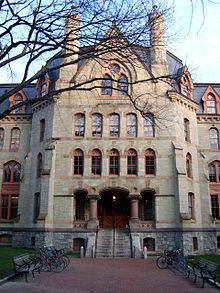Research, innovations and discoveries

Penn is classified as an "R1" doctoral university: "Highest research activity." Its economic impact on the Commonwealth of Pennsylvania for 2015 amounted to $14.3 billion. Penn's research expenditures in the 2018 fiscal year were $1.442 billion, the fourth largest in the U.S. In fiscal year 2019 Penn received $582.3 million in funding from the National Institutes of Health. In line with its well-known interdisciplinary tradition, Penn's research centers often span two or more disciplines. In the 2010–2011 academic year alone, five interdisciplinary research centers were created or substantially expanded; these include the Center for Health-care Financing, the Center for Global Women's Health at the Nursing School, the $13 million Morris Arboretum's Horticulture Center, the $15 million Jay H. Baker Retailing Center at Wharton and the $13 million Translational Research Center at Penn Medicine. With these additions, Penn now counts 165 research centers hosting a research community of over 4,300 faculty and over 1,100 postdoctoral fellows, 5,500 academic support staff and graduate student trainees. To further assist the advancement of interdisciplinary research President Amy Gutmann established the "Penn Integrates Knowledge" title awarded to selected Penn professors "whose research and teaching exemplify the integration of knowledge". These professors hold endowed professorships and joint appointments between Penn's schools.
Penn is also among the most prolific producers of doctoral students. With 487 PhDs awarded in 2009, Penn ranks third in the Ivy League, only behind Columbia and Cornell (Harvard did not report data). It also has one of the highest numbers of post-doctoral appointees (933 in number for 2004–2007), ranking third in the Ivy League (behind Harvard and Yale) and tenth nationally. In most disciplines Penn professors' productivity is among the highest in the nation and first in the fields of epidemiology, business, communication studies, comparative literature, languages, information science, criminal justice and criminology, social sciences and sociology. According to the National Research Council nearly three-quarters of Penn's 41 assessed programs were placed in ranges including the top 10 rankings in their fields, with more than half of these in ranges including the top five rankings in these fields.
Penn's research tradition has historically been complemented by innovations that shaped higher education. In addition to establishing the first medical school, the first university teaching hospital, the first business school, and the first student union, Penn was also the cradle of other significant developments. In 1852, Penn Law was the first law school in the nation to publish a law journal still in existence (then called The American Law Register, now the Penn Law Review, one of the most cited law journals in the world). Under the deanship of William Draper Lewis, the law school was also one of the first schools to emphasize legal teaching by full-time professors instead of practitioners, a system that is still followed today. The Wharton School was home to several pioneering developments in business education. It established the first research center in a business school in 1921 and the first center for entrepreneurship center in 1973 and it regularly introduced novel curricula for which BusinessWeek wrote, "Wharton is on the crest of a wave of reinvention and change in management education".
Several major scientific discoveries have also taken place at Penn. The university is probably best known as the place where the first general-purpose electronic computer (ENIAC) was born in 1946 at the Moore School of Electrical Engineering. It was here also where the world's first spelling and grammar checkers were created, as well as the popular COBOL programming language. Penn can also boast some of the most important discoveries in the field of medicine. The dialysis machine used as an artificial replacement for lost kidney function was conceived and devised out of a pressure cooker by William Inouye while he was still a student at Penn Med; the Rubella and Hepatitis B vaccines were developed at Penn; the discovery of cancer's link with genes, cognitive therapy, Retin-A (the cream used to treat acne), Resistin, the Philadelphia gene (linked to chronic myelogenous leukemia) and the technology behind PET Scans were all discovered by Penn Med researchers. More recent gene research has led to the discovery of the genes for fragile X syndrome, the most common form of inherited mental retardation; spinal and bulbar muscular atrophy, a disorder marked by progressive muscle wasting; and Charcot–Marie–Tooth disease, a progressive neurodegenerative disease that affects the hands, feet and limbs. Conductive polymer was also developed at Penn by Alan J. Heeger, Alan MacDiarmid and Hideki Shirakawa, an invention that earned them the Nobel Prize in Chemistry. On faculty since 1965, Ralph L. Brinster developed the scientific basis for in vitro fertilization and the transgenic mouse at Penn and was awarded the National Medal of Science in 2010. The theory of superconductivity was also partly developed at Penn, by then-faculty member John Robert Schrieffer (along with John Bardeen and Leon Cooper). The university has also contributed major advancements in the fields of economics and management. Among the many discoveries are conjoint analysis, widely used as a predictive tool especially in market research, Simon Kuznets's method of measuring Gross National Product, the Penn effect (the observation that consumer price levels in richer countries are systematically higher than in poorer ones) and the "Wharton Model" developed by Nobel-laureate Lawrence Klein to measure and forecast economic activity. The idea behind Health Maintenance Organizations also belonged to Penn professor Robert Eilers, who put it into practice during then-President Nixon's health reform in the 1970s.
Comments
Post a Comment